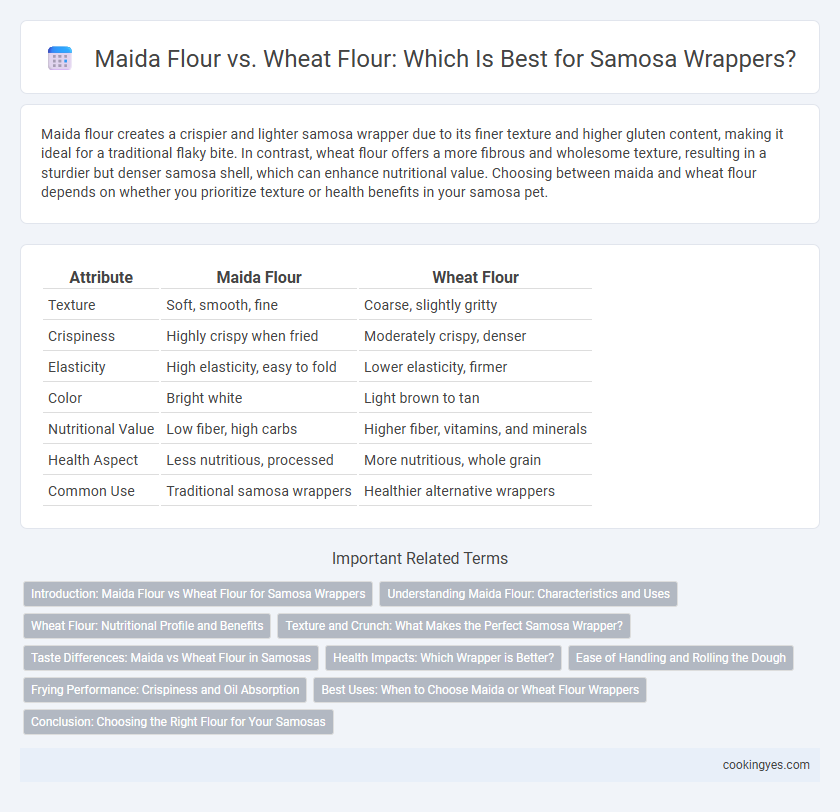Maida flour creates a crispier and lighter samosa wrapper due to its finer texture and higher gluten content, making it ideal for a traditional flaky bite. In contrast, wheat flour offers a more fibrous and wholesome texture, resulting in a sturdier but denser samosa shell, which can enhance nutritional value. Choosing between maida and wheat flour depends on whether you prioritize texture or health benefits in your samosa pet.
Table of Comparison
| Attribute | Maida Flour | Wheat Flour |
|---|---|---|
| Texture | Soft, smooth, fine | Coarse, slightly gritty |
| Crispiness | Highly crispy when fried | Moderately crispy, denser |
| Elasticity | High elasticity, easy to fold | Lower elasticity, firmer |
| Color | Bright white | Light brown to tan |
| Nutritional Value | Low fiber, high carbs | Higher fiber, vitamins, and minerals |
| Health Aspect | Less nutritious, processed | More nutritious, whole grain |
| Common Use | Traditional samosa wrappers | Healthier alternative wrappers |
Introduction: Maida Flour vs Wheat Flour for Samosa Wrappers
Maida flour produces samosa wrappers that are light, crisp, and have a smooth texture, making them ideal for achieving the classic flaky bite. Wheat flour, being whole grain, offers a denser, more fibrous wrapper with a nutty flavor, resulting in a thicker, chewier samosa crust. The choice between maida and wheat flour impacts the samosa's texture, taste, and nutritional value, influencing whether the snack is lighter or more wholesome.
Understanding Maida Flour: Characteristics and Uses
Maida flour, a finely milled refined wheat flour, is prized for its smooth texture and high gluten content, which makes samosa wrappers crisp and flaky when fried. Unlike whole wheat flour, maida flour lacks bran and germ, resulting in a softer, lighter dough that stretches easily without breaking, ideal for forming thin, uniform samosa skins. Its neutral flavor and fine particle size enhance the delicate taste and texture of samosas, making it the preferred choice in traditional Indian cuisine for perfect wrappers.
Wheat Flour: Nutritional Profile and Benefits
Wheat flour used for samosa wrappers offers higher fiber content and essential nutrients such as B vitamins, iron, and magnesium compared to maida flour, which is highly refined and stripped of these components. Its complex carbohydrates provide sustained energy release and better digestive health, making it a healthier choice for samosa preparation. The presence of antioxidants and protein in wheat flour supports overall well-being, enhancing the nutritional value of the samosas.
Texture and Crunch: What Makes the Perfect Samosa Wrapper?
Maida flour creates samosa wrappers that are smooth, light, and crisp, offering a delicate crunch that enhances the overall texture. Wheat flour, while healthier, produces a denser and less flaky wrapper with a slightly chewy bite, resulting in a more robust texture. For the perfect samosa wrapper, the fine gluten structure in maida flour is essential to achieve the ideal balance of crispness and tenderness.
Taste Differences: Maida vs Wheat Flour in Samosas
Maida flour produces samosa wrappers with a crispier texture and lighter, more delicate taste, enhancing the overall snack experience with a subtle, neutral flavor that complements various fillings. Wheat flour results in a denser, nuttier-tasting wrapper, offering a heartier flavor profile with increased fiber content, providing a wholesome twist to traditional samosas. The choice between maida and wheat flour significantly influences taste and texture, making maida ideal for classic, light samosas, while wheat flour suits those seeking a richer, more nutritious bite.
Health Impacts: Which Wrapper is Better?
Maida flour, refined and stripped of most nutrients, can lead to higher glycemic response and may contribute to weight gain and blood sugar spikes when consumed frequently in samosa wrappers. Wheat flour, being whole grain, retains fiber, vitamins, and minerals, promoting better digestion and more stable blood sugar levels. Choosing wheat flour for samosa wrappers supports improved heart health and sustained energy release, making it a healthier option overall.
Ease of Handling and Rolling the Dough
Maida flour offers superior ease of handling and rolling due to its fine texture and high gluten content, resulting in smoother, more elastic dough that stretches without tearing. Wheat flour, being coarser and lower in gluten, creates a denser dough that can be challenging to roll thinly without cracking. For perfectly thin and pliable samosa wrappers, maida flour is preferred by chefs seeking optimal flexibility and uniformity in dough preparation.
Frying Performance: Crispiness and Oil Absorption
Maida flour creates samosa wrappers with superior crispiness due to its fine, refined texture and lower protein content, resulting in a light, flaky crust after frying. Wheat flour, containing higher fiber and gluten, tends to produce denser wrappers that absorb more oil and yield less crunchiness. For optimal frying performance, samosa-made with maida flour achieves a crispy texture with minimal oil absorption, enhancing taste and reducing greasiness.
Best Uses: When to Choose Maida or Wheat Flour Wrappers
Maida flour creates a crispier, lighter samosa wrapper ideal for deep frying, offering a flaky texture that enhances the traditional samosa experience. Wheat flour wrappers lend a nuttier flavor and denser, chewier texture, better suited for baking or shallow frying, catering to healthier or whole-grain preferences. Choose maida for classic, crunchy samosas and wheat flour when seeking a more nutritious, rustic alternative with a firmer bite.
Conclusion: Choosing the Right Flour for Your Samosas
Maida flour creates samosa wrappers with a crispier texture and golden color, ideal for traditional deep-fried samosas, while wheat flour offers a healthier alternative with added fiber and a slightly denser texture. For authentic crunch and ease of folding, maida remains the preferred choice among chefs, but wheat flour suits those seeking nutritious options without compromising flavor. Selecting the right flour depends on balancing desired texture, health considerations, and cooking method to achieve perfect samosa wrappers every time.
Maida flour vs Wheat flour for samosa wrapper Infographic

 cookingyes.com
cookingyes.com